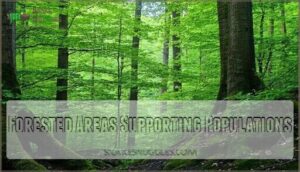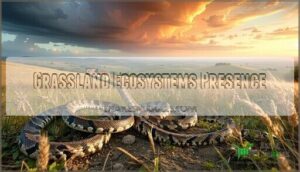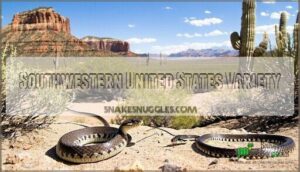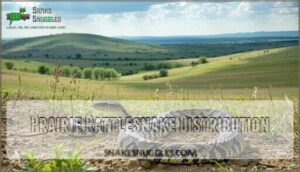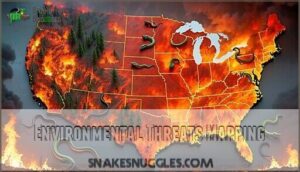This site is supported by our readers. We may earn a commission, at no cost to you, if you purchase through links.
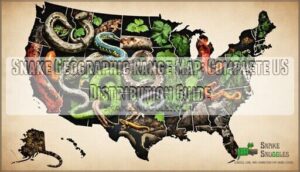 You’ll find snake geographic range maps covering over 150 species across the US, from Florida’s tropical diversity to the Southwest’s desert specialists.
You’ll find snake geographic range maps covering over 150 species across the US, from Florida’s tropical diversity to the Southwest’s desert specialists.
These maps show you exactly which venomous and non-venomous snakes call your area home.
Climate drives distribution patterns – that’s why you won’t spot rattlers in Alaska but might encounter several species in Arizona.
Geographic barriers like mountain ranges create fascinating isolated populations with unique traits.
The Southeast hosts the most species diversity, while northern states have fewer cold-hardy varieties.
What’s really interesting is how these traditional ranges are shifting as our climate changes and how this affects the overall snake population in terms of species diversity.
Table Of Contents
- Key Takeaways
- Snake Geographic Range
- Rattlesnake Habitat Diversity
- Snake Species Geographic Range
- Environmental Threats Mapping
- Coexisting With Snakes Safely
- Frequently Asked Questions (FAQs)
- Where are snakes located in the US?
- At what elevation are there no snakes?
- How far north can you find snakes?
- Which US state does not have snakes?
- How do I find out which snake species live in a state?
- Where do snakes live in North America?
- Where do rattlesnakes live in the winter?
- How do you identify a venomous snake in Virginia?
- How Can I Protect Rattlesnakes From Persecution?
- What Do Rattlesnakes Typically Eat?
- Conclusion
Key Takeaways
- You’ll find over 150 snake species distributed across the US, with the Southeast hosting the greatest diversity while northern states have fewer cold-hardy varieties
- Climate change is actively reshaping traditional snake ranges, forcing species to migrate northward and toward higher elevations as temperatures rise
- Desert environments in the Southwest support the most diverse rattlesnake populations, while specific species like eastern diamondbacks prefer coastal plains and prairie rattlesnakes dominate the Great Plains
- Understanding local snake distribution through range maps helps you stay safe during outdoor activities while supporting conservation efforts for these ecologically important predators
Snake Geographic Range
You’ll find snakes across every continent except Antarctica, with over 3,000 species calling different climates and regions home.
The United States hosts about 150 snake species, from desert rattlers in Arizona to water snakes in Florida swamps, showcasing a diverse range of species.
Global Snake Distribution
You’ll find snakes slithering across every continent except Antarctica, with over 3,500 species calling diverse habitats home.
Geographic isolation has driven remarkable species adaptation—from desert sidewinders to rainforest constrictors.
Snake migration patterns reveal how reptile distribution shifts with climate change, making habitat diversity essential for conservation efforts.
This snake habitat map shows nature’s incredible geographic range. The global snake distribution data highlights the complexity of their geographic range, illustrating the importance of conservation efforts.
Regional Snake Populations
You’ll find regional snake populations vary dramatically across the US, with Snake Migration patterns influenced by seasonal changes and food availability.
Population Trends show eastern regions support higher densities than western areas.
Habitat Fragment from Urban Encroachment creates isolated pockets where species struggle to maintain genetic diversity.
A thorough snake habitat map reveals how geographic range differs between species – you might spot timber rattlesnakes in Appalachian forests while finding sidewinders in southwestern deserts.
Snake Conservation efforts focus on protecting these distinct snake locations and maintaining corridor connections between fragmented habitats.
Climate Impact on Snake Habitats
Climate change reshapes where you’ll find snake species across America.
Temperature Effects force populations northward while Habitat Shift patterns create new snake territory boundaries.
Climate Modeling reveals dramatic Snake Migration routes as species track suitable conditions.
This Ecosystem Disruption transforms traditional species mapping data.
Researchers study climate change impacts to understand the effects on snake habitats.
- Rising temperatures push cold-adapted species toward cooler highlands and northern regions
- Altered rainfall patterns affect prey availability in traditional snake locations
- Extreme weather events fragment populations and disrupt breeding cycles
- Animal geography studies show some species expanding range by 100km annually
Rattlesnake Habitat Diversity
You’ll find rattlesnakes thriving across remarkably diverse habitats throughout the United States, from scorching desert floors to cool mountain forests.
These adaptable serpents have mastered life in arid southwestern deserts, dense eastern woodlands, and sprawling grassland prairies with equal success.
Desert Environments Favored
Desert rattlesnakes thrive where scorching temperatures would cook most creatures. These adaptable snake species have mastered arid adaptations that let them call sandy dune habitats home.
Their specialized kidneys conserve water while heat-sensing pits help them hunt at night when desert ecology cools down. Snake migration patterns follow seasonal temperature changes, maintaining ecosystem balance.
Desert conservation efforts protect these remarkable snake territory ranges across southwestern landscapes. Understanding their desert habitat needs is essential for effective conservation strategies.
Forested Areas Supporting Populations
You’ll discover that Forest Ecology creates perfect snake habitats through diverse Tree Species and layered canopies.
These woodland environments support thriving snake populations by offering hunting grounds, shelter, and temperature regulation.
Wildlife Conservation efforts focus on maintaining this Ecosystem Management balance, as forests provide critical species range expansion opportunities.
Understanding animal distribution patterns helps maintain reptile geography and ecosystem balance effectively.
Grassland Ecosystems Presence
Three major grassland ecosystems across America’s heartland support thriving snake populations through rich prairie ecology.
You’ll find species like the prairie rattlesnake calling these vast grasslands home, where ecosystem balance depends on healthy reptile geography.
Snake migration patterns follow seasonal changes, with animal distribution shifting as grass snake species adapt to temperature fluctuations and prey availability in these expansive habitats.
Snake Species Geographic Range
You’ll find specific snake species scattered across distinct regions throughout the United States, with each type adapted to particular climate zones and terrain features.
The southwestern deserts host the greatest variety, while eastern diamondbacks prefer coastal plains and prairie rattlesnakes dominate the Great Plains region.
Southwestern United States Variety
You’ll find over 40 Desert Species thriving across Arizona, New Mexico, and Texas, creating North America’s most diverse snake populations.
This incredible Habitat Diversity supports everything from tiny threadsnakes to massive indigo snakes.
Wildlife Management efforts focus on protecting these venomous snakes and harmless species alike, as Regional Conservation becomes essential for maintaining healthy ecosystems and Snake Behavior patterns.
Understanding the various snake species in texas is essential for effective conservation and management strategies.
Eastern Diamondback Range
You’ll encounter the Eastern Diamondback across coastal plains from North Carolina to Florida and west to Louisiana.
This massive rattlesnake thrives in pine forests, scrublands, and sandy areas.
Eastern Habitat changes affect Diamondback Conservation efforts substantially.
- Geographic Isolation limits populations to fragmented coastal regions
- Venomous snakes like diamondbacks face habitat loss from development
- Wildlife conservation programs track range expansion into new territories
Prairie Rattlesnake Distribution
You’ll find prairie rattlesnakes roaming across the Great Plains, from Canada down to Mexico.
These adaptable reptiles thrive in grasslands, prairies, and semi-arid regions where habitat loss increasingly threatens their traditional territories.
Snake migration patterns show they’re expanding eastward, demonstrating remarkable rattlesnake behavior adaptation.
Geographic isolation creates distinct populations, making wildlife conservation efforts essential for prairie ecology preservation and understanding herpetology’s role in maintaining biodiversity across their vast geographic information systems.
Environmental Threats Mapping
You’ll find that environmental threats are rapidly reshaping snake distribution patterns across the US, making traditional range maps less reliable each year.
Climate change, urban sprawl, and increasing wildfire frequency are forcing snake populations to either adapt their territories or face local extinction, due to climate change.
Climate Change Impacts Distribution
Climate change reshapes snake distribution patterns through Temperature Shift and Sea Level Rise effects.
Climate change forces snakes to chase cooler temperatures, reshaping centuries-old habitat boundaries.
You’ll observe Species Migration as warming drives snakes toward higher elevations and latitudes.
Ecosystem Disruption fragments traditional ranges, forcing snake migration into new territories.
Geographic information shows 52% of species face range contractions while others expand 136-251%.
Wildlife research reveals herpetology studies tracking snake behavior changes across fragmented landscapes nationwide.
Habitat Loss Due Expansion
As urban expansion sprawls across landscapes, you’ll witness habitat destruction that fragments snake populations into isolated pockets.
Human encroachment transforms continuous ecosystems into scattered remnants, forcing snakes into obstacle avoidance behaviors around developed areas.
Here’s how development disrupts snake geographic range:
- Deforestation impact removes critical shelter and prey sources
- Ecosystem disruption breaks natural corridors between habitats
- Wildlife research shows fragmented populations struggle with genetic diversity
This habitat loss creates wall avoidance scenarios where snakes can’t access traditional territories, fundamentally altering their distribution patterns across regions.
Understanding snake habitat maps is essential for conservation efforts to mitigate the effects of habitat loss.
Effects of Wildfires Populations
Beyond habitat destruction, wildfires create devastating ripple effects through Wildlife Ecology, causing immediate Snake Mortality and long-term Population Decline.
You’ll witness Habitat Destruction that transforms entire ecosystems overnight.
Ecosystem Disruption affects prey availability and shelter options.
Like chasing a high score in snake game online gaming with addictive gameplay multiplayer challenges, snakes must navigate increasingly hostile terrain where survival becomes the ultimate game.
Coexisting With Snakes Safely
Living alongside venomous snakes doesn’t mean you can’t enjoy outdoor activities—you just need to know what you’re doing.
Simple precautions and understanding snake behavior can keep both you and these important predators safe in shared habitats, which is crucial for shared habitats.
Safety Precautions Encountering Snakes
Stay calm when you spot a snake – most species aren’t venomous, but proper snake avoidance keeps you safe.
Wear sturdy boots and long pants as safety gear in snake country. Keep your distance, avoid sudden movements, and don’t corner them against walls.
Learn basic first aid for snake bite emergencies and know local venomous species identification. Understanding snake handling safety is essential for coexisting with snakes safely.
Snake Relocation Programs
Professional snake relocation programs use specialized techniques to safely move venomous species away from populated areas.
Trained experts safely relocate dangerous snakes using proven techniques that protect both communities and wildlife.
These wildlife conservation efforts require trained handlers who understand snake behavior and migration patterns. Success depends on proper species research and habitat restoration at release sites.
Effective snake relocation also involves understanding the importance of proper snake removal equipment, including tools for safe snake relocation.
- Relocation Methods: Short-distance moves (under 1km) show higher survival rates than long-distance relocations
- Snake Handling: Certified professionals use specialized equipment to safely capture and transport venomous species
- Wildlife Conservation: Programs balance human safety with species preservation through strategic habitat management
Public Education Coexisting Snakes
Since community education creates understanding between humans and snakes, you’ll find programs teaching Snake Awareness through interactive workshops.
Education Programs use Snake Safety demonstrations, while Public Outreach campaigns share Coexistence Tips.
Some programs even use nostalgic games like the classic snake game or Google Snake Game to engage kids, making snake education as addictive as classic arcade games.
Effective coexistence strategies often rely on coexistence guides to promote peaceful human-snake interactions, utilizing coexistence guides for better outcomes.
Frequently Asked Questions (FAQs)
Where are snakes located in the US?
You’ll find snakes thriving throughout the US, except in Alaska, Hawaii, Maine, and Rhode Island.
Around 100 different snake species can be found throughout the United States, with every other state hosting at least one species.
At what elevation are there no snakes?
Wondering about thin air limits? You’ll find snakes become extremely rare above 9,000 feet, with rattlesnakes reaching up to 9,500 feet in Colorado.
Some hardy species like garter snakes can survive at 11,000 feet.
How far north can you find snakes?
You’ll find European adders thriving north of the Arctic Circle in Norway and across northern Scandinavia.
These hardy vipers are found farther north than any other snake species, breaking cold barriers that freeze out their cousins, showcasing their ability to survive in extreme conditions as hardy creatures.
Which US state does not have snakes?
Alaska is the only state with a zero snake population.
You won’t find any slithering serpents calling the Last Frontier home – it’s simply too cold for these cold-blooded creatures to survive permanently.
How do I find out which snake species live in a state?
About 70% of all US snakes don’t exist in cities.
Start with your state’s natural resources or wildlife department website for official snake species lists.
You can also use snake identification apps like SnakeSnap for photo-based identification.
Where do snakes live in North America?
You’ll find snakes across North America’s diverse habitats – from deserts and forests to wetlands and grasslands.
They’ve adapted everywhere, thriving in hot southwestern deserts, cool northern forests, and everything between, which includes diverse habitats and thriving in various environments.
Where do rattlesnakes live in the winter?
About 30% of rattlesnakes share communal winter dens called hibernacula.
You’ll find them huddled below the frost line in rock crevices, rodent burrows, or caves, mainly from late October to early February.
They enter brumation, not true hibernation.
How do you identify a venomous snake in Virginia?
You’ll look for Virginia has only three venomous snakes: copperheads, cottonmouths, and timber rattlesnakes.
Timber rattlesnakes have rattles and small head scales, while copperheads show reddish-brown coloring with hourglass bands.
Copperheads display copper-colored heads with tan-to-pink bodies and dark brown hourglass patterns. Check for heat-sensing pits between eyes and nostrils on these dangerous species.
How Can I Protect Rattlesnakes From Persecution?
Looking to become a rattlesnake defender? Educate your community about their ecological benefits—they control rodent populations effectively.
Support wildlife conservation groups, report harassment to authorities, and create habitat-friendly spaces on your property.
What Do Rattlesnakes Typically Eat?
You’ll find rattlesnakes are opportunistic predators that primarily hunt small mammals like rodents, rabbits, and ground squirrels. They’ll also take birds, lizards, and amphibians when available opportunities arise.
Conclusion
Picture yourself scanning a detailed snake geographic range map, tracing colorful boundaries that reveal nature’s intricate distribution patterns.
These maps aren’t just pretty pictures – they’re essential tools for understanding where you might encounter different species.
Your snake geographic range map serves as both a safety guide and conservation resource.
Whether you’re hiking Arizona’s deserts or exploring Florida’s wetlands, knowing local species helps you stay safe while appreciating these remarkable reptiles.
Climate change continues reshaping these ranges, making current maps more valuable than ever.
- https://en.wikipedia.org/wiki/Snake
- https://www.numberanalytics.com/blog/global-snake-diversity-distribution
- https://www.reddit.com/r/MapPorn/comments/18umihm/worldwide_distribution_of_snakes_note_how_there/
- https://aaacwildliferemoval.com/blog/snakes/a-snakes-habitat/
- https://repfocus.dk/BIO/FAM_ORDER_CLASS/Serpentes_biodiversity_02_I_map.html


